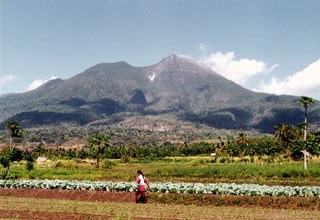Report on Egon (Indonesia) — 16 December-22 December 2015
Smithsonian Institution / US Geological Survey
Weekly Volcanic Activity Report, 16 December-22 December 2015
Managing Editor: Sally Sennert.
Please cite this report as:
Global Volcanism Program, 2015. Report on Egon (Indonesia) (Sennert, S, ed.). Weekly Volcanic Activity Report, 16 December-22 December 2015. Smithsonian Institution and US Geological Survey.
Egon
Indonesia
8.676°S, 122.455°E; summit elev. 1661 m
All times are local (unless otherwise noted)
PVMBG reported that during October-November seismicity at Egon was at baseline levels, characterized by an average of one event per day of both deep and shallow volcanic earthquakes. On 15 December the network recorded 29 shallow volcanic earthquakes, a number significantly above baseline. PVMBG raised the Alert Level to 2 (on a scale of 1-4) that same day and advised residents and tourists to stay at least 1.5 km away from the crater.
Geological Summary. Gunung Egon, also known as Namang, sits within the narrow section of eastern Flores Island. The barren, sparsely vegetated summit region has a 350-m-wide, 200-m-deep crater that sometimes contains a lake. Other small crater lakes occur on the flanks. A lava dome forms the southern summit. Solfataric activity occurs on the crater wall and rim and on the upper S flank. Reports of eruptive activity prior to explosive eruptions beginning in 2004 are unconfirmed. Emissions were often observed above the summit during 1888-1892. Strong emissions in 1907 reported by Sapper (1917) was considered by the Catalog of Active Volcanoes of the World (Neumann van Padang, 1951) to be an historical eruption, but Kemmerling (1929) noted that this was likely confused with an eruption on the same date and time from Lewotobi Lakilaki.
Source: Pusat Vulkanologi dan Mitigasi Bencana Geologi (PVMBG, also known as CVGHM)

